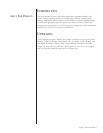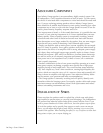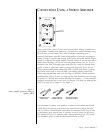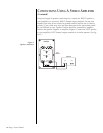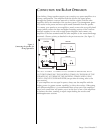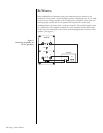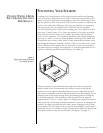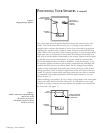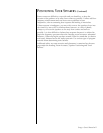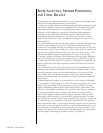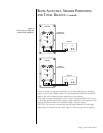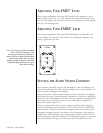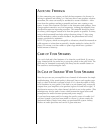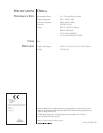
12
◆
Omega – Owner’s Manual
ROOM ACOUSTICS, SPEAKER POSITIONING
AND TONAL BALANCE
If you desire a more detailed description of room acoustics and speaker place-
ment, the following information may prove helpful:
• Large areas of glass, mirrors and wood paneling will reflect sound waves and
may result in harshness and excessive brightness. You can reduce the sound
waves reflected by hard surfaces by utilizing softer surfaces. For example,
draperies or wall hangings do a good job of absorbing high frequencies.
Placing a soft, absorbent piece of furniture near the hard surface often
helps reduce unwanted sound waves. Be careful not to absorb too much
sound as this will interfere with sonic balance, causing overall sound to be
dull and lifeless.
• A good listening room has just the right amount of reflection and absorbtion.
To test the sonic balance of your room, stand in the location where the
speakers will be installed and clap your hands two or three times. If the room
is reverberant, you will hear a sharp echo. If the room is dull, the sound of the
clap will decay rapidly and there will be very little or no echo. In fact, it will
seem that the higher frequencies generated by the clap will be missing.
• Furniture, pictures, bookcases, tables and lamps will help reduce unwanted
reflections because they are located at random points in the room. Carpeting
or throw rugs also help reduce floor reflections, although heavy carpeting can
absorb a great deal of the high frequencies, which will make the room seem
“bass heavy.”
• It is customary to place the speakers facing into the long dimension of the
listening room; however, this doesn’t always result in the best sound. At times,
placing the speakers facing into the short dimension of the room will yield
better results due to the acoustic properties of the room and the listener’s
position. Experiment with room placement. You may be pleasantly surprised
at the results.
• Maintaining absolute phase is an essential factor in the proper performance
of your speakers. If all amplifiers (as well as the other components in the audio
chain) were noninverting (if their outputs were always in-phase with their
inputs), maintaining absolute phase would simply involve observation of the
polarities of the speaker connecting wires. However, since there are amplifiers
(as well as preamplifiers and CD players) that invert the output from the
input, some changes in speaker hookup may be required in order to restore
the system to absolute phase. If your amplifier, preamplifier and CD instruc-
tion manuals do not state if these audio components are inverting, assume they
are noninverting, since 98 percent of all audio components do not invert the
audio signal at the output. If you wish to determine whether or not your com-
ponents are inverting, contact your dealer, or write to the manufacturer. If you
are certain that your amplifier is an inverting type, it will be necessary to dis-
connect your speakers and reverse polarity (on both speakers) so that positive
becomes negative and negative becomes positive. (See figure 8.)





